Eurasian “steppe belt”: at the origins
Journal “Nature”, 2008. No 3, pp. 34-43 (In Russian)
Posted text is from on-line publication
| Türkic Archeology |
| E.N. Chernykh Eurasian “steppe belt”: at the origins Journal “Nature”, 2008. No 3, pp. 34-43 (In Russian) Posted text is from on-line publication |
|
Foreword
|
||||||||||||||||||||||||||||||||||||||||||||||||
|
The most salient ethnological trait of the majority of the Türkic people was nomadic horse husbandry. Salient because it impacted the history, culture, technology, biology, and language of the Eurasian peoples as did no other ethnicity. The economy was a base, the Eurasian steppe belt was a highway. Not all Türkic people were engaged in the nomadic horse husbandry, some found convenient niche elsewhere; not all Türkic people used the steppe belt highway, some found other highways. Their impacts, however important, are compatible with impacts of other non-nomadic nations, and fall far short from the impacts of the nomads. The nomadic mobility greatly amplified their capabilities, and enabled them to crisscross Eurasia at will, and make it an ethnic backyard. Numerous aspects converge to describe the multi-faceted nature of the Eurasian highway. This posting illuminates the march of metal during the Copper and Bronze Ages, traces the role of the steppe conveyer belt in delivering the blessings of the metal across Eurasia, and lays out inventions made on the way. What would be the state of the modern humanity if the nature did not endow people with the Eurasian steppe highway? The Americas, Africa, Oceania, and Australia give us a subject lesson. They remained in Stone Age till a full swing of modernity, well into the Middle Ages. Time was frozen there. Neither China, nor India would have received literacy and metal technology. Numerically, they would be compatible with Americas and Africa, but the Stone Age technology would have had frozen their development. The Carpathian metallurgy and Mesopotamian literacy would not have reached them, leaving them ages behind. And the Chinese and Indian inventions would have been parochial knowledge, leaving Europe without silk, gun powder, and enlightenment. We would likely still be using candles and asspower. The kind nature gave our ancestors a magic highway, and we have used it to the fullest. The 10-page synopsis by the corresponding member of the Russian Academy of Sciences (RAS) E.N. Chernykh is technically a yesterday news, the study was published in Cambridge in 1992, and by now, 20 years later, the Metallurgical Provinces are a staple knowledge, but the accent on the dynamics of the steppe belt instead of the mundane metal technology addresses aspect that still remains a subject unfathomably non grata. The extent of the status is manifested in the brilliant synopsis: talking about the steppe belt and Türkic people that made that belt to move, the authoritative corresponding member of the RAS managed to not mention the people even once; the closest he came to the Türkic people was to mention the Mongols and Chingiz Khan. It takes a special knowledge to know that “Mongols” were better than 95% Türkic, and that Chingiz Khan was a descendent of the Uigur dynastic line Djalair, of which the Chingiz Khan's Borjigin was a descendent branch. That the outstanding scientist has to use euphemisms, code-hide his true meanings, and recite an old propaganda booklet on the terrible Rus' sufferings, that attests that a scientist in Russia still has to watch his back when dealing with history, and even with the pre-historic technical aspect of the history. But the ice has broken off, and the E.N. Chernykh's synopsis is a best testimony to that. As far as we can see, in the pre-historical period, the Eurasia was dominated by agglutinative languages. The Türkic-lingual haplogroup R1b formed in the South Siberia 16,000 years ago (ybp), 7,000 ybp it expanded via northern Kazakhstan, where Botai culture domesticated wild horse no later than 5,500 ybp, and across the territories of the Middle Volga, Samara, Khvalynsk, the Kurgan Pit Grave archaeological cultures/complexes, 6,000 ybp it passed through the Caucasus to Anatolia, through the Middle East 5,000 ybp and Northern Africa 4,000 ybp it crossed over to the Iberian Peninsula 4,800 ybp, and further on to the continental Europe 4,200 – 4,000 ybp, and to the British Isles 3,800 – 3,350 ybp. The path from the Pyrenees to the Continental Europe is the path and period of the Beaker Culture, the ancestors of the Pra-Celts and Pra-Italics. The flexive languages probably descended from the haplogroup I, which sent its refugees from the Balkans to the Scandinavia and Eastern European refuges after the calamity of the “killing fields” 5,000 ybp. By the beginning of the Copper Age period, about 5,300 ybp, the Eurasian steppes were already domesticated and populated by the productive Türkic herders. The E.N. Chernykh's synopsis describes events after the Black Sea deluge of 7,300 ybp, when the geography approached that of the modern times, and indirectly reflects the following samplings of cultures and people.
Posting's notes and explanations, added to the text of the author and not noted specially, are shown in (blue italics) in parentheses and in blue boxes. |
||||||||||||||||||||||||||||||||||||||||||||||||
|
E.N. Chernykh Åâðàçèéñêèé “ñòåïíîé ïîÿñ”: ó èñòîêîâ ôîðìèðîâàíèÿ |
||||||||||||||||||||||||||||||||||||||||||||||||
A look at the problem
At the apogee of its development, the Eurasian “steppe belt” of the pastoral cultures to the eyes of the modern researchers rises as truly boundless in its huge extent. From west to east, from the basin of the Lower Danube to the Manchuria - actually without any noticeable breaks - extended a space of more than 8 thousand km. At the same time, territories fully occupied by mobile warlike steppe peoples covered to 16-17 million km2 (Fig. 1) - and that was in relatively “peaceful” periods of existence! 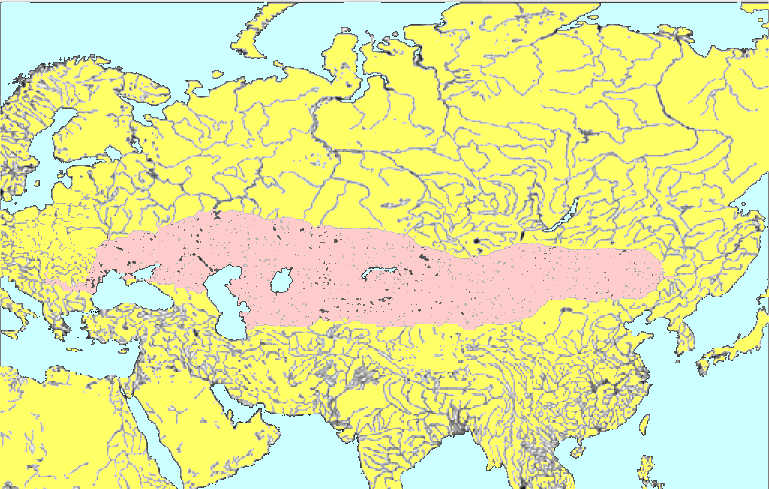 For a very long time the steppe zone served as a peculiar “domain” base of the pastoral cultures. However, the “domain” also included forest-steppe regions located to the north and ecologically much more comfortable for the steppe pastoralists. In addition, these populations roamed everywhere, coaching not only in the semi-desert, but even in the little suitable habitation desert regions; from the Caspian Karakums (Black Sands) and Kyzyl Kums (Red Sands) to the Gobi in the center of the Asia. The shepherds from the steppe communities were also not so rare to be encountered at the southern outskirts of the mountain taiga regions (for example, in the Sayan-Altai or other areas). For this reason, the concept of the “steppe belt” should be understood as a rather conditional term: in reality the “belt” included in its orbit much more extensive expanses. Nor should be thought that from the worlds of the southern - settled farmers - and northern -
forest hunters and fishermen - people this “belt” was separated by defined demarcation boundaries.
In essence, on the contrary, throughout its vast extent and in virtually at all stages of its
existence, existed very notable in their territorial scope regions where was observed interspersed
coexistence of various types of cultures. The steppe pastoralists, staring from the Bronze Age until the Middle Ages, from time to time deeply penetrated the aborigine regions of the settled agricultural cultures. In the historical reality, the spread and geographic penetration of the “steppe belt” cultures always had a wave-like character. In the case of success, the dynamic cattlemen warriors could subjugate alien populations in truly boundless territories. The colonial ambitions of the steppe folks as a rule were aimed to the south of their “domain”, where they tried to foray deep into the zone of the settled agricultural cultures. On a sudden weakening, they were immediately retreating to the north. Note one extremely important fact also. Almost always behind them remained cultures of the giant northern taiga zone of the Eurasia. Apparently, they almost always to a greater or lesser extent depended on the steppe. Evidently, the steppe pastoralists did not fear a treacherous “strike in the back”: the forest tribes of hunters and fishermen seemed to be too weak and fragmented. However, from there, from the north, in the final phase of their existence fell the most tragic blow for the steppe pastoralists.
In the past six millennia, i.e. until the modern times or up to the 18th and 19th cc., the Eurasian “belt” of the steppe cultures without a doubt was one of the most remarkable phenomena in the history of the peoples of that continent. The periods of the destructive, unprecedented in their swiftness invasions of the riders - those undefeatable in those historical moments soldiers - not rarely were plunging into literal paralysis the will of many peoples belonging to the sedentary cultures. In the long historical memory of the people which are habitually classed in the category of “civilized” not only in the scientific literature, but also even in popular novels, usually pop up the pictures of the past amply stained with blood and curse of total destructions. Not only the written sources, but also the tale narratives and epic legends are filled with such memories. “Who are these fiends? Where did these non-humans came from? From what deserted depths? Is it from the outlandish and God-damned Tartar country? It is said that these devilish creatures feed on carrion and speak tongues unknown to anyone. Apparently, for the grave sins of ours the God could send down to us a this hellish calamity.” Many rulers of the Christian Europe, up to the British Isles [1], struggled in the 13th c. with such knotted questions. Similar lamentations at the same time also rung in most parts of the Asia. It was in connection with the beginning of the Chingiz' conquests. The all-embracing Eurasian Chingizid empire of course was a true apogee, and also a final act of the steppe violence, its peculiar “swan song”. The tradition of a huge mass of sharply negative assessments of the crushing medieval Mongol conquests persevered in the world literature to the present day. And probably the only one known to the author researcher, L.N. Gumilev, proved to be an energetic and consistent apologist for these devastating catastrophes, which, as he has declared in his many publications, were no catastrophes at all. However, the Mongol conquests that horrified the world only completed a long series of such disasters. For example, the predecessors of Chingiz Khan and his immediate successors were the Huns with their legendary leader Attila. They also appeared in the west of the Eurasian continent from the unknown to the Europeans and terrifying them depths of the Asia. The indomitable Hunnic horsemen struck smashing blows to both the eastern and the western parts of the once unitary Roman Empire. Descending down the chronological scale and crossing the line of the new era, we immerse
into the steppe world of the Scythians-Sarmatians. In the 1st mill. BC it extended from the lower
Danube to the western Mongolia.
The richest and often saturated with gold kurgan burials of the Scythian-Sarmatian leaders still hotly excite research archaeologists and the general public. At the end of the 6th c. BC a Persian King Darius, intending to punish and crush with his army just a small speck of that immense nomadic world, suffered a total failure. That was described in detail by Herodotus, and his narrative clearly outlined that kernel of the strategic invulnerability of the steppe horsemen that reigned in all preceding and subsequent epochs (actually to the Modern Times). In all likelihood, China experienced the most serious agony from the extremely painful and sometimes tragic encounters with the world of the steppe cultures. That struggle lasted for no less than three millennia, until the late Middle Ages. And if in the more western Eurasian territories the southern world was separated from the northern steppe world by mighty mountain chains, from the Caucasus to the Pamir and Tien Shan, the Chinese in fact had to endlessly build and reconstruct their famous “Great” Wall, which is almost always turned out to be an extremely weak barrier against the flying troops of the “steppe cowboys”. The first signs of the Eurasian inception of the “steppe belt”, that steppe phenomenon that terrified so many, appeared at the very beginning of the Early Metal or the Copper Age, that is in the 5th mill. BC After about 35-40 centuries, i.e. by the end of the 2nd mill. BC, the boundaries of the “steppe belt” received the forms that in their main features have endured for the next three millennia. Clearly, a short article can only identify the general stages in the development of the “steppe belt” during the Early Metal Age, they can be reduced to three steps. The foundation of the present study were the extensive databases on the ancient metal in the various metallurgical provinces, accumulated and systematized by the author and the staff of the RAS Archaeology Institute's Laboratory of natural science methods. Just the issues raised in this article involved a database in excess of 120 thousand artifacts, and the number of systemically processed 14C radiocarbon dates approached three thousand measurements. The first signs (5th mill. BC) In the 5th mill. BC in the Old World in the space from the Adriatic Sea up to the Lower Volga region appeared the first metallurgical province of the Copper Age (Fig. 2). We named it the Balkan-Carpathian, since its major producing metallurgical centers are localized in the mountainous areas of the northern Balkans and Carpathians rich with copper ore [2]. There, copper was smelted from numerous ore deposits, and from it were produced manytools and weapons (Fig. 2). The tools and ornaments in the more eastern regions, deprived of the mineral wealth steppe and forest-steppe expanses of that part of the European continent, could only be forged or cast from the imported Balkan-Carpathian copper. The forming of a complex interconnected system of metallurgical and metal centers, which constitutes a metallurgical province, was an event of an utmost importance. Ultimately, this event began gaining a truly global nature. After all, there was conceived the real metallurgical production of our planet, and was made one of the most important steps in the foundation of the modern civilization. That this province formed in the north of the Balkans and in the Carpathians, at first surprised many
people. According to old and seemingly inviolable axioms of the historical and
archaeological sciences, that production could not possibly appear there earlier than what was known
in Mesopotamia, or say, in Egypt. Because the postulate “Light from the East” seemed to be unshaken: only in
the Middle East, and not before the 3rd mill. BC, could arise all anyhow remarkable ideas and
technologies. But the Balkan-Carpathian basin is quite removed from the biblical plains... Introduction of radiocarbon chronology in the arsenal of the main archeological methods had shaken dramatically the former notional image: the actively developing analytical studies with each new step inexorably asserted much deeper antiquity of the rudimentary, but at the same time strikingly highly developed Balkan-Carpathian metallurgy. A - the central
segment of cultures;
B - segment of Tripolye cultures; C - segment of steppe pastoralist communities. Above: left - copper tools and weapons from the central segment (Varna necropolis); right - copper jewelry from the monuments of the steppe cultures. 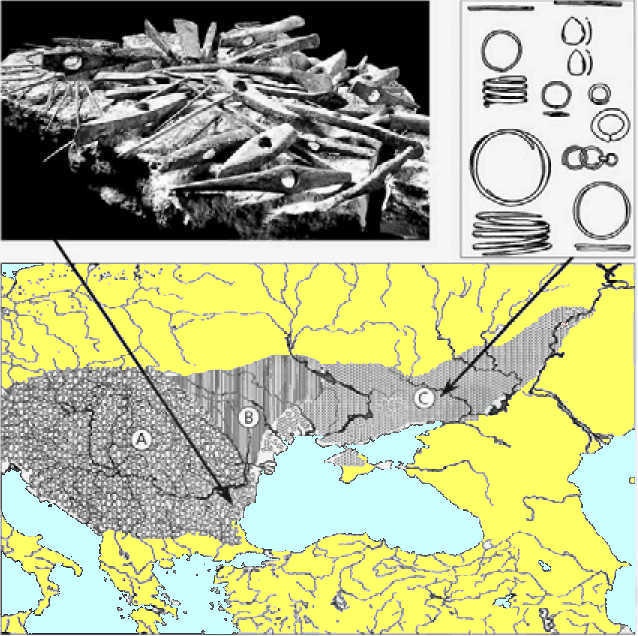 The Balkan-Carpathian Metallurgical Province (BCMP), along with production of heavy copper tools and golden ornaments, is distinguished by a number of notable traits, of which one trait is a very important for our subject. In the structure of the province cultures are easily distinguished three parts. The first is an indigenous or central part: the whole daily life of the people was located in the permanent long-term settlements. These ancient settlements have powerful multi-meter deposit layers that archaeologists call “cultural layer”, they have countless fragments of superbly made and elaborately decorated pottery. The aborigines lived in mud houses, sometimes two-story dwellings. One of the most important occupations of these people was agriculture, but professionally distinct clans among the populations were working mines and smelting copper. The second category of cultures was located east of the Carpathians, in the areas of the modern Western Ukraine reaching the right bank of the Dnieper river. Their monuments are known as a quite famed Tripolye culture (named so after the town Tripolye near the Dnieper river, where was located one of the first monuments discovered by the archaeologists). Very similar to the Balkan-Carpathian monuments, it differs only by the absence of the metal mining. The local tribes used imported metal from the metallurgical centers of the central part. But the most interesting for our theme in the system of the Balkan-Carpathian Metallurgical
Province is perhaps the
Eastern bloc of the cultures in the steppe and forest-steppe area of the Eastern Europe from the Dnieper
river to the Middle and Lower Volga. All notable details of the material or spiritual life sharply contrast
with those of their western neighbors. The farming there was absolutely unknown, and the main
source of livelihood and concerns was the cattle. As a rule, the villages were marked by a thin
“cultural layer”, which pointed to a much more mobile life. In a greater extent the steppe culture became known due to the excavations of its cemeteries. The clay vessels differed by incomparably more primitive forms and making techniques. They received metal from the Balkan-Carpathian production centers via the Tripolye tribes, from the imported copper the steppe people only forged some simple form decorations (Fig. 2), and for some unknown reason they shunned altogether the copper tools and weapons. Even a cursory comparison of the first and second segments of the settled agricultural cultures on one hand, and the third segment of the steppe cattle-breeding population of the Eastern Europe on the other hand allowed many archaeologists to hold that these people are of two very different levels of social and technological development. In the west live and work populations essentially approaching the level of the early civilizations, while the steppe east has “barbarian” cultures, totally dependent on the “enlightened” west. Well, it seems that the time has come to proclaim an entirely new axiom, the “Light from the West”?
At the source of the steppe Kurgan cultures - the second stage (4th mill. BC) But already in the next 4th mill. BC the picture has changed dramatically. The Copper Age was replaced with the Early Bronze Age, and came a second stage in the developing of the “steppe belt”. South-east from the area of pastoral communities that constituted the third block of the Balkan-Carpathian Metallurgical Province, in the steppes and foothills of the North Caucasus, emerged a culture that until then did not have analogies or explicit prototypes. People were often buried there under huge mounds called in the new time kurgans. The most majestic artificial gravestones hills distinguished in all probability the persons with the highest social status.
The deceased were often placed in a large stone “boxes”, lined with stone slabs. Those buried under large kurgans were often accompanied by strikingly rich inventory: bronze weapons and utensils, gold and silver vessels, and ornaments (Fig. 3), and also objects for mysterious rituals. Archaeologists began to call that culture Maikop, since the first amazing for its wealth burial had been excavated in the city of Maikop still in the late 19th c. 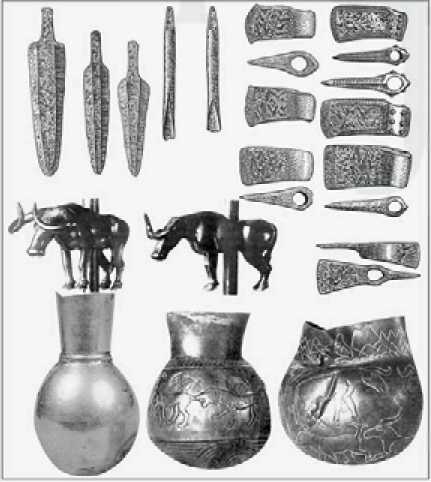 Many most important features and paradoxical distinctions of the Maikop culture were continuously attracting researchers' attention. First, was always noted the bright originality of that kurgan and largely cattle-breeding culture against the background oif the distant and immediate neighbors. Sedentary farmers surrounded its area from the south, largely beyond the Main Caucasus ridge.
The steppe pastoralists, the “third segment” of the Balkan-Carpathian Metallurgical Province,
occupied the northern steppe and forest-steppe. Second, the wealth and diversity of the metal products was conspicuously almost fantastic. The last feature particularly intrigued archaeologists, because until now was found no evidence of local metal production by the Maikop population, and in the southern territories, beyond the Caucasus ridge, the metal collections from the monuments of the settled agricultural cultures badly paled compared with the splendor of the Maikop culture. [3] Third, on the background of the Maikop kurgan cemeteries' splendor, was conspicuous a pale, if not sometimes primitive, appearance of the majority of the settlements. And finally, fourth, was striking the very early age of the Maikop monuments, that covered all ten centuries of the 4th mill. BC. That shocked particularly the supporters of the “Light from the East” theory, because in this case, the once undisputed historical axiom suffered quite significant damage. The Maikop phenomenon was developing against the backdrop of the fading Balkan-Carpathian Metallurgical Province, but aside from it and independent of it. When the province finally dissolved, its area was absorbed by completely new and much more extensive system called Circum-Pontic Metallurgical Province (CPMP). The name of the province was given because the main producing centers of this system were located around the Black Sea (Fig. 4), or Pontus Euxine of the ancient Greeks. The metallurgy and metalworking of the CPMP in their main characteristics significantly differed from the vanished in time Balkan-Carpathian Metallurgical Province. And the Maikop culture, with its large kurgans and awesome metal, in a way was largely an “ancestress” of the Circum-Pontic province. Within the CPMP system, the status of the primarily Maikop culture, and also of the later Eastern European steppe communities that became its heirs, such as the so-called Pit Grave culture, differed sharply from what was observed for the preceding Copper Age. The northern CPMP zone (Fig. 5) now had pastoralist mobile Kurgan cultures and communities, sometimes explicitly “showcasing” their independence of the southern sedentary peoples, as well as their special significance. By tradition, the pastoral tribes to this day at times continue to be called barbaric. However, these “barbarians” from the 4th, and mainly already in the 3rd mill. BC began their activities so frightening for the sedentary “civilized farmers”. Receiving a major share of the metal from the rich southern countries, they vigorously develop their own metalworking production. Sometimes even might be received an impression the southerners tried to “buy off” with their metal the aggressive shepherd warriors.
Now among the people of the Kurgan cultures comes to the fore the casting of the tools and weapons, and some of these forms, for example battle axes, even become a starting point for large series of similar products in the Middle East or Asia Minor. For example, an analysis of the bas-relief images in the southern regions shows the axes of the steppe forms in the south being weapons of very high rank: they are in the hands of only the highest hierarchs and even of the deities. At the same time, at the end of the 4th mill. BC, the nomadic peoples of the Kurgan “Pit Grave” archaeological community discovered in the Southern Urals steppes a giant Kargaly copper ore field. Among the shepherds crystallized groups of people with professional skills, who had learned the skill of smelting the copper ore, and from it the forgings and castings for various kinds of products.
In the 3rd mill. BC the nomadic pastoral societies, and also the societies of the mobile “semi-sedentary” shepherds occupied impressive territories in excess of 1 million km2, from the lower Danube to the northern Caspian semideserts. Not quite clear traces of their impacts can even be seen far in the east, up to the steppe Altai. However, the realization of their eastern expansion (so far difficult to prove) was postponed for another thousand years. 7 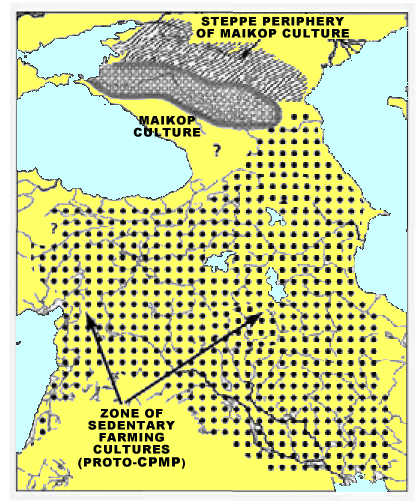
Areal of the Pit Grave cultures and its expected eastern parallels  The third stage of development: East - West (3rd-2nd mill. BC) The turn of the 3rd and 2nd mill. BC clearly exposes the most important features in the third stage of developing the “belt”, and in the Eurasian continent were budding communities of the Late Bronze Age. It was a time of fantastic activation of the steppe pastoralists, which led to the “steppe belt” gaining a quite clear and complete nature of its contours by the middle of the 2nd mill BC. During the Late Bronze Age the metal-based cultures of the Old World reached their territorial peak of 40-43 million km2 [3].
The “steppe belt” of the pastoral societies also came close to its highest values of 16-17 million km2. Consequently, in the common space of the cultures and communities who have known metal and its benefits, the share of the steppe confederations accounted for at least 40% of the whole area, and this is very impressive! In the history of the “steppe belt” nations during the Late Bronze Age a special role played two
giant metallurgical provinces, the Eurasian and East Asian. The Eurasian province spread its influence from
the Dnieper area to the Altai, and from the steppe and semi-desert areas of the N.Caucasus and
Middle Asia to the
taiga north (Fig. 6). It differed by distinctly monocultural nature of its population, which is
especially evident in the stabilization phase of the 18th/17ht-15ht/14ht cc. BC. By that time its
total area reached approximately 8 million km2. Its all southern part occupied monuments
of two giant groups: the so-called Timber Grave in the Eastern Europe, and Andronovo in the Eastern Asian part.
However, the start or the initial phase in the formation of this “monocultural” province seemed very
unusual. Stabilization phase.  The early phase of the Eurasian province, dated 28-22 cc. BC, is remarkable because of the start of two swift counter-propagating “waves” of the pastoral peoples' migration from the west to the east and from the east to the west (Fig. 7). The first or the western impulse appears to be quite expected against the backdrop of the previous time. At the end of the 3rd mill. BC in the process of the Circum-Pontic Metallurgical Province decay, the pastoralists of the Eastern Europe steppe and forest-steppe regions flocked to the east, beyond the Urals. This led to a rapid spread of the pastoral lifestyle among the peoples of Kazakhstan, the steppe and semi-desert parts of the Middle Asia, and the south of the Western Siberia. Two counter-propagating waves in the spread of the cultural formations.
Asterisks denote tombs and sanctuaries, points and oval shapes denote isolated finds of metal of the Seima-Turbino appearance 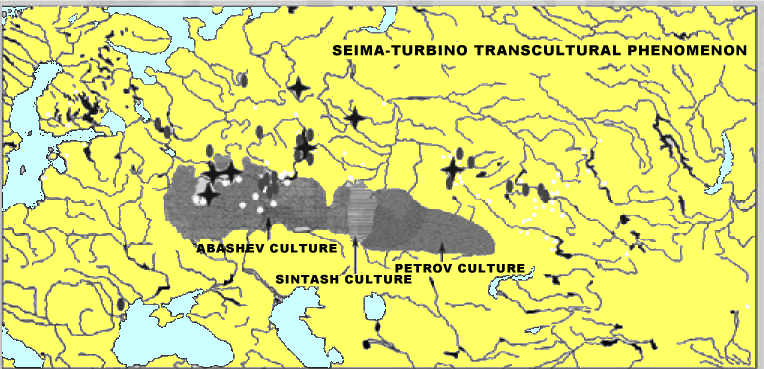
The initiators of this movement were people who left behind monuments where archaeologists
recognize the so-called Sintashta or Abashevo-Sintashta community. The Petrov culture also belonged
to that community (Fig. 7). As before, the populations of that community still disdained
agriculture, and without doubt, the animal husbandry remained central to their daily lives. Also, on the basis of the
copper ore deposits east of the Urals and in Kazakhstan, there was successfully developing the metal mining industry. The kurgan cemeteries almost disappeared beyond the Urals: the ancient ritual of construction grave mounds was quickly dying there. Archaeologists discovered many villages of that community, but as a rule the settlements were not impressive with their large size.
The second “wave” (or the eastern impulse) was much more unexpected for the researchers. Its mystery at least stemmed from the difficulty of predicting and suggesting such a “wave”. After all, almost from “nowhere” in the vast areal of the Sayano-Altai mountain system very quickly arose very developed type of metallurgy. The relatively primitive metallurgical centers of the preceding period seem did not promise a sudden burst of high-tech production of thin-walled bronze castings of fine and perchance unique forms of weapons. There were cast spearheads, kelt axes, curved knives with sculpted images of various animals and even humans (Fig. 8). The vast majority of these objects were found in very strange cenotaph graves, where archaeologists have found no human remains. [4] The width of the distribution area of these unusual antiquities is amazing: from the Western and even Central China, to the Eastern Baltic, i.e., more than six thousand km! But in this enormous territory was also amazing the surprisingly small number of these metal objects: not more than six hundred were found! 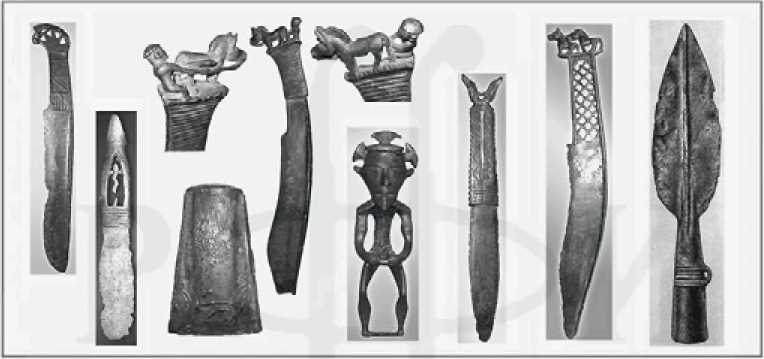
However, precisely so “ignited” the first birth signs of another great metallurgical province, which we call East Asian Metallurgical Province. Compared with the Eurasian Metallurgical Province it had a much more complex structure. In the archeology, the eastern “wave” is known as the Seima-Turbino transcultural phenomenon (after two famous cemeteries: Seima and Turbino). The warlike populations rapidly moved westward in parallel, but to the north from the oncoming wave of the Abashevo-Sintashta tribes, primarily along the southern strip of the Eurasian forest zone. Extremely interesting that 35-40 centuries later by the same path but heading eastward would as swiftly move not numerous Cossack detachments, these restless and undisciplined subjects of the Russian state.
However, in the second half of the 2nd mill. BC the nomadic pastoralists of the East Asian
Metallurgical Province
dramatically changed the orientation of their aggressive intentions. Henceforth, their eyes focused
mainly on the southeast (Fig. 9), where rose richest cultural centers of the ancient Chinese
state called Shang (Yin), which centers are mainly connected with the Huanhe (Yellow River) basin.
The steppe extracts, whose culture archaeologists call Karasuk, inherited many weapon forms from the prior Seima-Turbino phenomenon,
first of all casting the so-called single-edged curved knives with decorated handles (Fig. 8).
These forms of weapons, or rather their imitations, spread throughout the
territory subject to the rulers of the Shang Dynasty. Apparently, from that time originated the
great confrontation between the steppe pastoral warriors and ancient and medieval Chinese civilizations. 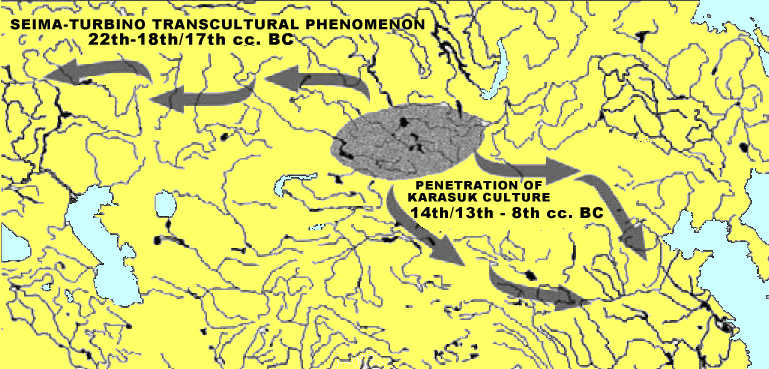 Finale We have already recalled the “stellar hour” of the steppe pastoralists - about the Chingiz campaigns and almost lightning creation of the short-lived Eurasian Chingizid empire (actually, not that “short-lived”, the last Chingizid ruler was displaced in 1917 from the Khiva Khanate, thus the Chingizids survived for 711 years, far longer than the Romanovs' 304 years. Who is “short-lived”?). The Mongolian tribes' kurultai had raised Chingiz Khan on a white felt in 1206 (actually, not the “Mongolian tribes' kurultai”, but the Bordjigin family kurultai, which in Türkic means “family gathering to arrange family affairs”, lit. “be cured (family) ties”). However, already in 1241, i.e. just 35 years later, the Mongol flying troops crushed all opponents in the truly vast territory, from the Pacific Ocean to the Adriatic. These lightning conquests swept truly gigantic territory, up to 30 million km2! However, soon enough gradually began to transpire the sunset features of the steppe phenomenon. However surprising, but most devastating blows to the nomads struck that nation that has experienced one of the most severe losses from their invasions, the Russian nation (actually, Rus suffered the least of all Chingizid dominions, and gained the most. After 300 years of continued internecine carnage, Rus enjoyed 250 bloodless years; of all the dominions, Rus alone was given a full autonomy; the Rus annual tax was in single digits thousand rubles, a small fraction of others' taxes, and about 2 pennies per family per year; the Ruses collected taxes themselves, enriching their elite way more than Mongols; the Rus church was state-protected and exempted from taxation; and finally, the Rus peasantry was free, the slavery started after Mongols were long gone. The propaganda myth of “suffering” was invented 200 years after Mongols were gone, the process of enslavement was in its peak, and during the Soviet times was used as a tool of the state-run genocide). It should be remembered, however, that their greater or lesser dependence from the steppe warriors was felt for a long time. After all, the Russian state paid tribute to the Crimean Tatars until the time of the Peter the Great (i.e. the Rus, Russian Tzardom, and Russian Empire paid tribute to the Chingizid Girais till 1750s, or for 500 years, quite an achievement for the “short-lived Eurasian Chingizid empire”). However, the energetic breakthrough to the east, beyond the Urals, of the Russian Cossack units began in 1580s, soon after Ivan the Terrible crushed the Kazan Khanate. This push is well known in our literature, and it is of course linked with the legendary in Russian history name of Ermak (Ermak, of course, was a Türkic mercenary, his Türkic name Ermäk means “existential, being”, and Yermäk means “despicable, vile”). Just six decades took Cossacks after his campaign to reach the eastern extremity of the Eurasian continent: Dejnev rounded this cape, the future Bering Strait that separates the Old World from the New World, in 1648. Thus, Russia gradually seized and mastered that taiga rear of the “steppe belt” which, as one may think, the steppe pastoralists held eternal and immutable. The new and overhanging from the north mighty force gradually and steadily pressed on the steppe nations. Their resistance, however, was very long and desperate. At first was overran the western flank of the “belt”, in the Russian tradition called the “wild steppe”. That action, as is known, glorified the Catherine the Great favorite, Prince Potemkin the Taurean.10 Much later they succeded to subjugate the central part of the “belt” - Kazakhstan and Middle Asia. So, in 1820, i.e. nine decades after the Junior Juz of the Kazakhs was annexed to the Russian Empire, the capital city authorities organized an embassy to Bukhara via Orenburg (Bukhara, like the Khiva, in 1820 was ruled by a Chingizid Sheibanid offspring). “Since we had to cross the vast steppes, visited only by the nomadic hordes, the government supplied us with an escort of two hundred Cossacks and two hundred infantry, which then were joined by twenty-five Bashkir cavalrymen. We took along two artillery guns”, - wrote then the embassy's statistician E. Meyendorff [5]. However, after elimination in the second half of the 19th c. of the independence of the Middle Asian emirates, in that part of the Asia the “steppe belt” finished. At the end of the 2nd millennium, only in the arid Mongolian steppes and the vast deserts of Gobi could be observed remains of the nomadic and semi- pastoralists (Fig. 10) (actually, the credit for dismemberment of the Middle Asia nomadic horse husbandry must be given to Stalin and Stalinism, who stripped the cattle from the nomads under a cover of “collectivization”, and let horses and people starve to death for no purpose and without any means of sustenance. That happened in 1930s, few years before the WWII, when a few million horses could feed the starving and bleeding country. During the hungry days after the fall of the Stalinist system in 1990s, the slowly recovering animal husbandry sustained millions in Kazakhstan and Turkmenistan.) 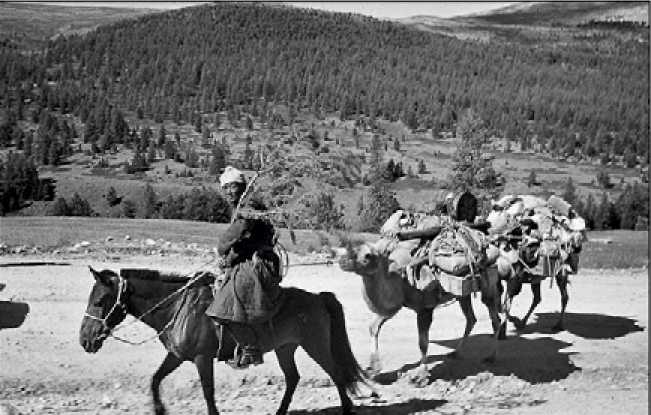 Such appeared the finale of the saturated with dramas and tragedies of life of that striking phenomenon of the distant, and not so distant, history of the Eurasian “steppe belt”. REFERENCES 1. Yurchenko A.G., Exposition//The Christian world and the “Great Mongol Empire”. Materials of the Franciscan mission in 1245, St. Petersburg, 2002. |
||||||||||||||||||||||||||||||||||||||||||||||||